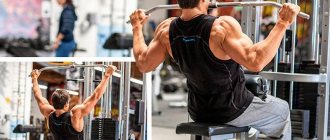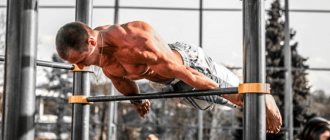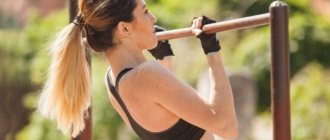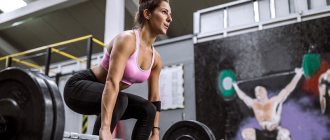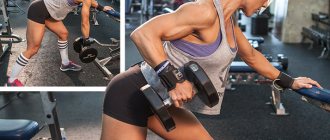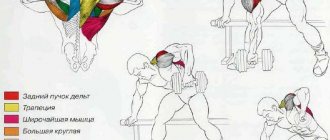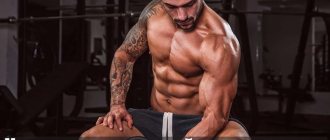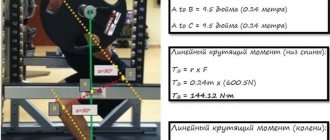Advantages and disadvantages of working in a vertical block
In continuation of what has been said about the safety of the simulator, I will clarify that the pull of the upper block does not load the spine, but, on the contrary, stretches the vertebrae thanks to the counterweight, which makes the exercise safe for diseases such as hernias, protrusions, pinched nerve endings, but only with moderate weight . Also, training on the upper block will be the right choice for beginners who have not yet strengthened their muscles, and performing barbell rows, dumbbells or other basic exercises can be traumatic.
This does not mean that exercises on a vertical block are completely safe.
If the technique is not followed, injuries to the shoulder joint are possible, which occur when the arms are sharply extended upward, which injures the joint capsule.
It is also possible to rupture the long head of the triceps , which is directly involved in bringing the arm to the chest. This can be caused by muscle overload due to excessive working weight at a time when the back muscles turn off and the triceps take on the entire load.
Following proper exercise technique and choosing the right weight will not only prevent injury, but will also improve your workout performance.
Technique and types of extensions on the block
After attaching one of the handles to the block and setting the desired weight, you need to take the handle with a direct grip, choosing the most comfortable hand position. The main thing is that the grip should not be wide, but at a level slightly narrower than shoulder width.
When performing the triceps extension itself, you need to make sure that your elbows are pressed to your sides and motionless during each movement. The back should be straight. The body can be slightly tilted forward, but without rounding the back or hunching the shoulders.
When performing extensions, your legs can be kept straight, or better yet, slightly bent at the knee joints. It is also allowed to put one leg slightly forward (i.e., so that your feet are not at the same level). Here you just need to experiment and choose the position of your legs that will be the most stable and comfortable for you.
When the hands with the handle are in the highest position, we inhale. And as we straighten our arms, we exhale with effort. At the final lowest point of extension, it makes sense to take a short (second) pause in order to feel the peak contraction of the muscle. Your arms must be straightened completely. So that the handle touches the upper thighs.
But at the top point, the hands with the handle should not be brought to the end a little, to their highest state. Because the muscles there are already relaxing, and the load is removed from them. For high-quality training, we need to ensure a constant load throughout the entire exercise. All movements should be slow, rhythmic and controlled.
If you follow all these subtleties of the correct technique, you will feel that it is your triceps that are clogged, and other muscle groups are not included in the work at all. With the exception of the muscles of the forearm, which play an auxiliary and supporting role in extensions on the block.
Classic extensions
When performing triceps extensions on the upper block, you can and should use all the handles for the block machine that are available in your fitness room. Small changes in grip, which are provided by the use of different types of handles, will help to work the triceps muscle from different angles.
For example, a V-shaped handle targets the outer part of the triceps, while a straight bar puts stress on the long heads of the triceps. According to many athletes, the cable handle provides the deepest pumping of the triceps. It allows you to “reach” the deepest muscle fibers of the triceps muscle.
Whatever type of handle you choose, in any case, classic triceps extensions imply pulling only from the upper block. This exercise is performed standing. The legs, slightly bent at the knees, are positioned shoulder-width apart (or one leg is slightly extended, as if taking half a step forward, for greater stability).
Perform arm extensions on a block so that only the elbow joint is working. To do this, the elbows must be motionless, fixed in a position pressed close to the body. Under no circumstances should you turn extensions into presses!
The classic and absolutely correct execution of this exercise does not imply any forward bending of the body. Because the more the athlete leans forward, the more he will (voluntarily or not) help his triceps with the weight of his own body. And this already removes a significant part of the load from the muscle being worked. You only need to use the strength of the triceps, and nothing more.
Extensions with rope handle
To change the nature of the load and just for variety, when performing exercises for triceps extension in a block, you should pay special attention to the rope handle. That is, in addition to extensions using metal handles, you also need to include exercises with ropes or special straps in your training.
This equipment allows you to stretch your triceps harder. The amplitude of movements will become close to maximum if you extend your arms not just down, but down/to the sides (spreading them apart at the lowest point). This way, it will be more difficult to perform the exercise with proper technique, so you need to choose less weight.
It is important to allow the cable with a rope handle to perform the greatest range of motion when performing biceps extensions in the upper block, remembering to “catch” a second pause in the lower position of the arms to ensure peak muscle contraction.
It is not without reason that the variety of arm extensions with a rope handle of the upper block is considered the most effective by many experienced athletes. After all, the rope handle provides very high-quality isolated work and exceptionally strong contraction of the triceps, with a predominant load on their lateral bundles.
Bent handle extension
Another highly effective way to work the triceps in a standing block is to perform arm extensions with a curved handle. The curved metal handle facilitates partial rotation of the hands: the right hand – clockwise, and the left hand – counterclockwise. In this situation, the main part of the load falls on the outer heads of the triceps.
This exercise is also performed while standing. The torso is not necessarily held in a strictly vertical position during this triceps pulley movement. To balance the stand, you can slightly tilt your body forward. Also, to maintain the correct body position, you must not change the direction of your gaze: always look straight ahead.
With the correct technique for performing this exercise, the arms from shoulder to elbow are strictly perpendicular to the floor. This position does not need to be changed when straightening your arms. This way you can achieve the best development of all the muscle fibers of the long head of the triceps. When lowering the palms turned to the sides downwards, a powerful contraction of the medial fascicles of the triceps occurs (with an ordinary straight grip, extension of the arms is carried out by contraction of the long fascicles).
Don't overdo it with the weight load. If you overdo it with weight, then part of the load will inevitably transfer to other muscle groups, which will also be involved in the work. And this completely defeats the purpose of this triceps exercise.
Wide grip lat pulldown to chest
The exercise develops back thickness by increasing the load on the middle of the latissimus muscles.
What muscles work
- Latissimus dorsi muscles.
- Teres major muscle.
- Biceps brachii.
- Shoulder muscles.
- Additionally included: trapezius muscle, rhomboid muscle, pectoralis major muscle.
Execution technique
- Place a wide handle on the upper block, grab it from above with a wide grip.
- Lower yourself into the seat with your arms extended above your head. Place your hips under the special fixing rollers.
- Lean your body back slightly, maintaining this position throughout the approach.
- As you exhale, bend your elbows and , using the efforts of your back muscles, bring your shoulder blades together , bringing the handle to the clavicular part of your chest, while protruding your chest, forming a deflection.
- Do not touch the sternum with the handle; fix the tension at the lowest point.
- As you inhale, smoothly straighten your elbows, maintaining the position of your body.
- At the top point, smoothly straighten your arms, gently stretching your shoulder joints, without jerking.
- Repeat the movement.
Upper pulley to the chest in video format
Technique
Pulldowns with a narrow or wide grip, behind the head or to the chest while sitting are variations of the same exercise. Each of them has its own characteristics that every athlete simply needs to know. This knowledge will give a tangible advantage when creating training programs using a block simulator.
Narrow grip
This is a reverse grip vertical row. Set the weight to 10–15 kg for warming up in the block machine. Adjust the seat so that your legs fit snugly between the seat and the leg support bolsters. If the bolsters are too low, you will not be able to sit properly. And if it’s high, a large weight will lift you up during exercise in the block simulator. Vertical rows with improper form are a bad idea. In this case, the position of the hands should be parallel.
- Stand up and grab the handle with a narrow reverse grip. The distance between the hands is 10–15 cm.
- Sit with your arms straight with the weight up, feel the weight.
- Using the strength of your latissimus muscles, bring your elbows down. At the same time, the handle (bar) of the exercise machine is pulled towards your chin.
- Raise your head slightly up so that your face does not interfere with the trajectory of the weight.
- Pull the handle down to your neck while sitting, trying to shorten your wings as much as possible: the weight should drop to your chest.
- There is no need to lean back, otherwise it will be a different traction option. We do everything while sitting, without lifting our pelvis from the seat.
- Hold the weight at the bottom for 1-2 seconds, then return to the starting position. Practice the technique with light weights. Warm-up is 10–15 repetitions.
Set the working weight to do 3 sets of 10 reps. If you can’t pull down on the last reps, or you need to do them with jerks, reduce the weight by 5 kg (usually the step in the block machine is just 5 kg).
This version of the exercise, along with the lats, actively uses the biceps, but the amplitude of movement is maximum.
Wide grip
Option 1: Reverse Grip and Pulldown
This is also a vertical row with a reverse grip. Place a weight of 10–15 kg and adjust the seat of the machine as described just above.
- Stand up and grab the handle with a moderately wide grip. Your hands should be slightly wider than your shoulders.
- Sit down, stretch your arms up. Lean back a little so that the cable of the block machine stretches under the weight of the weight you installed. Your torso is the counterweight.
- Pull the weight downward with the force of your wings so that your elbows point 45 degrees down.
- Bring the bar of the machine to the top of your chest, maintaining the angle of your body.
- Put the weight back. Do 10-15 warm-up reps.
Place a working weight and perform 3 sets of 12 times. This pull of the upper block to the chest pumps up the bottom of the wings.
Option 2: direct head grip
This is a vertical row with a wide grip behind the head:
- Grasp the bends of the bar with your hands with an overhand grip. This grip is considered wide.
- Sit down. The body must be positioned strictly vertically; deviations back or forward are inappropriate in this case.
- We tilt our head slightly down so that the back of the head does not interfere with the movement of the bar.
- Using the force of the wings, we pull the weight down behind the head, touching the neck.
- Hold the weight in the lower position for 1-2 seconds and return to the starting position.
- We do 10–15 warm-up approaches.
Next, set up a working weight and perform 3 sets of 10 repetitions while sitting. This version of the exercise will be more difficult and traumatic than the others, so it is better to use it for experienced athletes. It is believed to best engage the teres major muscle.
Option 3: straight wide grip to the chest
This is a vertical pull-down to the chest or a vertical pull-down with a wide grip to the chest:
- We grab the bar in exactly the same way as in the previous exercise.
- We tilt the body a little back, and also tilt the head a little back.
- Using the force of the wings, while sitting, we pull the weight to the top or bottom of the chest. In this case, by deflecting the body, we achieve the desired angle for proper muscle function. Such an effect cannot be achieved by pulling a horizontal block.
This pull of the upper block to the chest pumps the top of the latissimus muscles. In addition, there are handles for doing parallel grip rows. This is acceptable, but it is better to pull a horizontal block with a parallel grip.
Vertical block row for the head
The advantage of this exercise is to develop the width of the back muscles. This exercise prepares your back muscles for pull-ups and free weight exercises.
What muscles work
- Latissimus dorsi muscles.
- Teres major muscle.
- Biceps brachii.
- Shoulder muscles.
- Brachioradialis muscles.
- Lower part of the trapezoid.
- Rhomboid muscle.
Exercise technique
- Grab the wide handle with a wide grip from above, lower your pelvis onto the seat, straighten your arms above your head, lock your hips under the bolsters.
- Lean your body forward slightly, keeping your back straight.
- As you exhale, move the handle behind your head without touching the cervical vertebrae. Do not lower the handle below your neck. Bring your elbows towards your body by bringing your shoulder blades together, working concentratedly with your back muscles.
- Lock the muscles at the lowest point with maximum contraction.
- As you inhale, slowly straighten your arms above your head.
- Repeat the movement.
Pulldown of the upper block behind the head in video format
Common mistakes
Bending of the wrists.
Keep your elbows and bones level. Wrist curls will increase the load on the wrist and additionally recruit the latissimus dorsi muscles to perform the exercise. The level of load on the triceps will decrease, and the exercise will lose its effectiveness.
Straight body.
Fixing the body in its original position using the abdominal muscles and latissimus dorsi or stooping contributes to the development of spinal problems.
Small distance to block.
The weight will be pulled upward, and the exercise will require moving your elbows back. The load is redistributed to other muscles, and posture is also disrupted.
The block is too far.
Excessive forward bending will strain the lower back.
The head is lowered or looking to the side.
Keep your head strictly straight, this promotes normal posture and body position.
Reverse Grip Lat Pulldown
The exercise maximizes the thickness of the back muscles, especially the middle part. In this variant, the biceps of the shoulder are more involved in the work.
What muscles work
- Latissimus dorsi muscles.
- Teres major muscle.
- Rhomboid muscle.
- Pectoralis minor muscle.
- Shoulder biceps.
- Brachial muscle.
Exercise technique
- Place your palms on a wide bar, shoulder-width apart, with a reverse underhand grip, supinating your shoulder joints.
- Lower your pelvis onto the seat, lock your hips under the bolsters, slightly tilt your body back, maintaining the position throughout the approach.
- As you exhale, squeeze your shoulder blades, bringing your elbows towards your body, lower the handle to the upper part of the pectoral muscles, but do not touch them. Concentrating on the work of the back muscles, bring the shoulder blades towards each other as close as possible due to the deflection of the chest, in other words, make the chest a “wheel”.
- Try to perform the pull not with the biceps, but concentrated with the back muscles.
- As you inhale, smoothly straighten your arms at the joints, keeping your torso tilted back.
- Repeat the movement several times.
Reverse grip lat pulldown in video format
Description and features of the exercise
To pump up the back muscles, the athlete is required to concentrate and comply with the rules and regulations regarding the technique. In a block machine, vertical rows resemble regular pull-ups. The main anatomy is that at the time of execution, the biceps and the main muscle group - the broad back muscles - are involved. Therefore, it is important to perform deadlifts accurately and correctly, since this exercise is the best way to strengthen and maintain the muscular parts of the back.
Physical fitness, especially muscle development, must remain at the proper level, since exercise is characterized by the addition of weights. In this case, the mass of additional equipment can significantly exceed the person’s own body weight.
What muscles are involved?
In addition to the “wings” of the back, lat pulldowns additionally load the muscles:
- torso – abdominal and erector discs of the vertebrae;
- forearms and shoulder rotators;
- diamond-shaped, jagged anterior, lower and middle trapezoidal;
- wrist flexors, biceps.
The simulator includes different types of bars. The muscle groups of the shoulder girdle, which take on the secondary load, change significantly depending on the width of the grip and its type. To pump up the back muscles, especially the broad muscles, the biceps should take on a minimal part of the load during the exercise.
The chest row activates the abdominal muscles of the trunk - stabilizers, if you perform small, as light as possible bends back without introducing a large load mass.
One-arm vertical row using the trapezius and head of the biceps muscles strengthens the anterior and middle part of the deltoid muscles, the clavicular part of the pectoral muscle.
Benefits of doing it
Vertical rows do not require much time from the athlete and provide a number of benefits:
- beautiful back muscles;
- narrow waist and straight posture;
- the torso becomes V-shaped when viewed in profile;
- availability of execution in any gym or fitness room.
The lat pull-down is one of the simplest and most popular exercises in training, as the back muscles grow very quickly. That is why novice athletes perform this exercise as often as possible and with a large number of approaches. Pulls to the chest in parallel, with one grip, behind the head and others allow you to work your back in different planes and angles.
How is it different from pull-ups?
The block simulator, on which vertical rows are performed, is a direct analogue of the horizontal bar for simple pull-ups. Meanwhile, during the usual, well-known pull-ups, the main load involves the biceps, and the back works only 25-50%. The pull of a vertical block to the chest works exactly the opposite: the main load goes to the top, allowing you to pump the latissimus muscles of the dorsal region.
This exercise is also different in that the overhead row is performed while sitting. In this case, the projectile is pulled towards the body, and not the body towards the crossbar (projectile). Thanks to the block design with a seat, the exercises can be performed by people for whom pull-ups on bars are strictly contraindicated and those who do not know how to do pull-ups.
The ability to use different bars and additional weight (from 2 kg) is another significant difference from conventional pull-ups.
Why exercise for girls?
Depending on the goal and load, women can work on mass or exercise to “dry”, strengthen and pump the upper back and shoulder girdle. Using different variations (vertical row with a medium, straight, narrow or wide grip) allows girls to:
- master the correct pull-up technique;
- pump up the muscles of the arms and neck;
- strengthen the cervical vertebra;
- achieve a perfect V-shaped torso and narrow waist.
Who is contraindicated for
The lat pulldown has few contraindications. Block exercise machines can be found even in rehabilitation centers, where doctors strongly recommend performing this exercise. Caution should be exercised if the thoracic vertebra contains a hernia.
Vertical rows performed with one arm are not recommended if the shoulder girdle cannot or is not ready to make sudden amplitude movements. The exercise is strictly prohibited in case of severe elbow injuries, as well as in case of damage to the hands and shoulder muscles, since during the exercise there is a load on the shoulders.
Close-grip vertical pull-down (parallel)
The exercise works all parts of the latissimus dorsi and teres major muscles using a handle for a narrow parallel grip.
What muscles work
- Latissimus dorsi muscle.
- Teres major muscle.
- Biceps brachii.
- Brachial muscle.
- Brachioradialis muscle.
- Also involved: rhomboid and trapezius muscles, posterior bundles of deltoid muscles.
Features of the technology
- It is necessary to place a handle for a narrow parallel grip or an L-handle on the upper block.
- Grasp the handles and lower your pelvis onto the seat, securing your hips under the bolsters.
- Straighten your arms above your head, lengthening your spine.
- As you exhale, pull the handle toward your upper chest without touching. At the lowest point, it is important to form a deflection of the thoracic region , as if the chest is tending to the handle, bring the shoulder blades as close as possible to each other.
- As you inhale, gently release the tension, straightening your elbows completely.
- Repeat the movements.
Close-grip lat pull-down in video format
What is so special about vertical rows for women?
Classes in the block simulator are suitable for both men and women.
For girls, regularly performing vertical rows helps:
- gaining enough strength to perform more difficult exercises (for example, pull-ups or push-ups);
- achieving the desired result in the shortest possible time, regardless of the specifics of the goal itself (vertical traction is effective both in increasing the relief of the body and in improving strength indicators, as well as endurance of the muscles of the shoulder girdle);
- visual transformation of the décolleté area (by strengthening the pectoral muscles when performing exercises in a block design, the breast shape is tightened and slightly changed for the better).
Don't miss the most popular article in the section: Body drying for girls. Training program, detailed nutrition menu for the month by day.
One-arm lat pulldown
This exercise will allow you to work your back muscles more effectively. When performing the exercise on one side, the weight is not distributed on both hands, but focuses on the target muscles without the help of the stronger hand. Therefore, the craving becomes more concentrated. When choosing a working weight, divide the load with which you perform two-arm rows by two. For this exercise you will need a one-handed handle or a D-handle.
What muscles work
- Latissimus dorsi muscles.
- Teres major muscle.
- Biceps brachii.
- Shoulder muscles.
- Brachioradialis muscles.
- Lower part of the trapezius muscle.
- Rhomboid muscle.
Features of the technology
- Secure and grip the handle for one hand.
- Stand sideways, turning away from your working hand, and lower your pelvis onto the seat, while you can fix one thigh with a bolster, if this is convenient.
- Straighten your arm completely, and exhale, lower the handle to your shoulder, bringing your shoulder blade closer to the center of your back and your elbow closer to your torso. In this case, the shoulder should not turn, the elbow should look down.
- As you inhale, smoothly extend your arm to the starting position and repeat the movement.
- Then turn around in the other direction and repeat the same movement.
Seated one-arm lat pulldown in video format
Extension of arms on the upper block while standing video exercise
Conclusion
Standing arm extension on a block is a relatively simple exercise that has a large number of variations. Advantages of the technique:
• effective development of the lateral head of the triceps; • complete isolation of a muscle group; • low risk of injury; • high efficiency.
The triceps pulldown exercise is recommended as a completion of triceps development when exercises with heavy weights have already been completed. The most effective combination of pull-downs with triceps bench presses, push-ups and various modifications of arm extensions.
It is not recommended to start isolating exercises with blocks in the first year of training. Isolation and highlighting of the individual triceps heads is impossible without impressive definition and large volume of the arm.
Author: ForceMan from 04/07/2018, 09:00
- 1
What is better to do – pull-ups or lat pull-downs?
First, you need to understand that pull-ups are the pinnacle of perfection in physical fitness and not everyone can do it for various reasons. While everyone can perform lat pull-downs - both men and girls.
The vertical block row will be an excellent springboard in preparation for pull-ups, since the target muscles in these exercises are almost the same, the only difference is in the strength and capabilities of the athlete.
If we talk about effectiveness, of course, pull-ups involve more muscles, require more strength and endurance from the athlete and bring him closer to results - increased strength, muscles and endurance.
If pull-ups are feasible at least 2-3 times, they should be included in training and developed, and various rows will be additional exercises in the uniform development of the back muscles. Otherwise, rows will be the only way to strengthen your back until the muscles are ready for pull-ups.
And also read, leading exercises to pull-ups →
How to correctly do extension from the upper block while standing down
The triceps pulley press is classified as an isolation exercise for one of the triceps heads. A properly performed deadlift will only engage that specific muscle group. The load helps to increase the relief and shape of the hands.
What triceps extensions look like in motion (video)
Advantages
To perform lat pulldowns, you will need a cable trainer. The exercise does not involve muscles other than the triceps. Performing arm extensions from the upper block is aimed at achieving the following goals:
•
increased strength of the triceps muscle; • isolated triceps load; • formation of hand relief; • reduction of skin “wings” in the shoulder area; • increase in arm volume; • strengthening of pressing characteristics.
What is it and what is it used for?
This exercise perfectly complements the complex for pumping the back muscles. In some sources you can find an interpretation of this exercise as basic, but this is not entirely true. We recommend using it as an auxiliary exercise, which should be performed immediately after the basic one: this will have a greater effect.
It is performed on a special simulator, which looks like a bench with a fixed handle that must be pulled towards you. At the other end there is a load, the weight of which can be adjusted depending on the fitness of the athlete.
